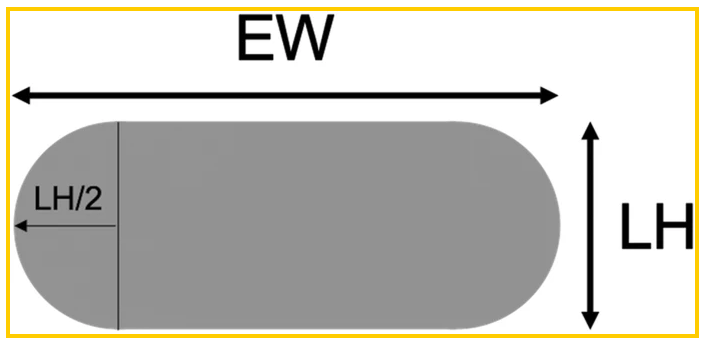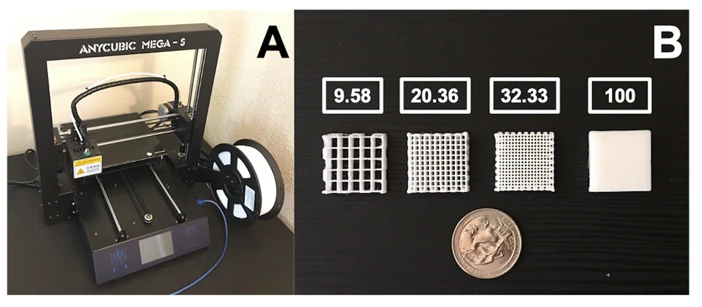Prashanth Ravi brings additional data to light in a recently published study, ‘Understanding the relationship between slicing and measured fill density in material extrusion 3D printing towards precision porosity constructs for biomedical and pharmaceutical applications.’ Helping us to understand more about the effects of slicing and porosity in biomedical applications, Ravi explores basic yet crucial printing parameters like fill density in FDM (FFF, Material Extrusion).
While such topics have been the center of numerous research studies from use with 3D printed medical models, to materials like PLA, and new techniques and settings, in this study Ravi investigated discrepancies and deviations regarding the measured and slicing fill density for smaller-sized prints with low fill and high porosity.

Schematic showing the cross-sectional shape of an extruded bead assumed by Slic3r. The EW and LH can be set in the software prior to slicing to adjust the bead aspect ratio as desired

Schematic showing the cross-sectional view of two adjacent beads within a single layer. The area used for fill related calculations is boxed in red
Samples were 3D printed in structures measuring 20mm x 20mm x 5mm with fill density values of 9.58%, 20.36% and 32.33%, in triplicate. An Anycubic Mega-S 3D printer was used for the fabrication of the samples, with PLA as the material of choice.
“A temperature of 220 °C, print speed of 20 mm/sec, LH of 0.2 mm and EW of 0.4 mm were set in the slicer,” explained Ravi. “The fill pattern was set to Rectilinear with 0/90 alternating fill angles and the number of perimeters/outlines was set to 0.
“To ensure proper calibration of the extruder steps a 100% fill density was set in Slic3r and the imported 20 mm × 20 mm × 5 mm STL was printed in triplicates and weighed using a precision digital weighing scale (Newacalox 8028, Newacalox, USA).”

The 3D printer used for validating the predicted fill density percent calculations (a) and 20 × 20 × 5 mm3 samples (right) with the respective Slic3r fill density percent values in inset boxes shown with a quarter dollar coin (~ 24 mm diameter) for scale (b)
Ravi focused on gaining more understanding regarding error in fill calculations, often arising from ‘discretization of the number of beads in addition to the ignored bead-to-bead interconnect extrusion.’ With the fill densities reduced, Ravi found that that the number of extruded beads was reduced too.
“Such a trial and error approach was necessary because Slic3r performs an internal scaling of the part size before generating n,” noted Ravi.
Triplicate samples were also printed at 15% and 40% Slic3r fill density for further confirmation of the approach.
Ultimately, Ravi found that the measured fill density percentage was as much as 3.5 percent greater than that of the Slic3r fill density percent.
“At low fill densities the measured fill density was found to deviate substantially from the slicing fill density with average absolute errors greater than 26% in certain instances for a 20 mm × 20 mm × 5 mm cuboidal construct. The predictive fill density percent model in the study estimated fill density to well within 5% of the measured fill density percent values at all five low fill density settings, since the model is based on the actual slicer (Slic3r) toolpath and takes into account the material extruded in the bead-to-bead interconnects,” concluded Ravi.
“The approach presented in this study could be used to predict construct fill density with reasonable accuracy based on slicing parameters in Slic3r. The methodology could prove useful in biomedical and pharmaceutical applications requiring accurate control of fill density for relatively small sized constructs to meet targeted functional criteria such as compressive strength and content release rate.”
What do you think of this news? Let us know your thoughts! Join the discussion of this and other 3D printing topics at 3DPrintBoard.com.
[Source / Images: ‘Understanding the relationship between slicing and measured fill density in material extrusion 3D printing towards precision porosity constructs for biomedical and pharmaceutical applications’]Subscribe to Our Email Newsletter
Stay up-to-date on all the latest news from the 3D printing industry and receive information and offers from third party vendors.
Print Services
Upload your 3D Models and get them printed quickly and efficiently.
You May Also Like
Heating Up: 3D Systems’ Scott Green Discusses 3D Printing’s Potential in the Data Center Industry
The relentless rise of NVIDIA, the steadily increasing pledges of major private and public investments in national infrastructure projects around the world, and the general cultural obsession with AI have...
3DPOD 260: John Hart on VulcanForms, MIT, Desktop Metal and More
John Hart is a Professor at MIT; he´s also the director of the Laboratory for Manufacturing and Productivity as well as the director of the Center for Advanced Production Technologies....
Etsy Design Rule Change Reduces Selection of 3D Printed Goods
Online marketplace Etsy has implemented a rule change requiring all 3D printed goods on the site to be original designs. The update to the site’s Creativity Standards states, ¨Items produced using...
E-Beam OEM Wayland Additive Partners with USC Racing to 3D Print Titanium Exhaust Collector
Every year, standards organization SAE International holds a competition called Formula SAE, in which students from both undergraduate and graduate programs design, build, and race small formula-style race cars. For...

































